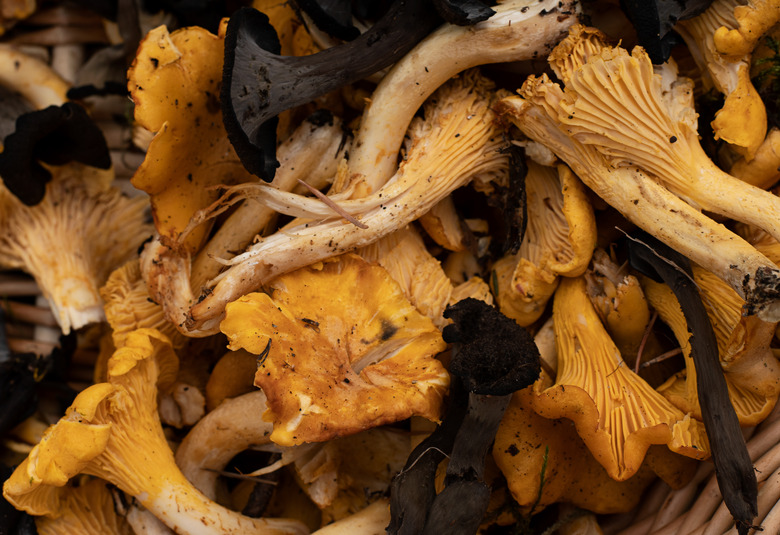How To Pick Wild Mushrooms In Ontario
Ontario has over 5,000 species of mushrooms. Some Ontario mushroom species are edible, and others are poisonous. Ontario mushroom hunting is an enjoyable and rewarding outdoor activity done under the guidance of a local mycologist, or someone who studies mushrooms. Common mushroom hunting expeditions in Ontario look for chanterelles, black trumpets and oyster mushrooms.
Warning
Learn how to identify edible and poisonous mushrooms from an experienced mycologist before trying to forage for mushrooms yourself.
Wild Mushroom Hunting in Ontario
Wild Mushroom Hunting in Ontario
Mushrooms are the fruiting body of a fungus (plural: fungi). Fungi use mushrooms to spread their spores - the equivalent of seeds on a plant – to produce new fungi.
When picking wild mushrooms, use two fingers to pinch the base of the mushroom stem and break it off. This technique helps avoid pulling anything out of the ground, which would damage the fungi's body of hyphae. Young mushrooms should also be left alone as they have not yet had a chance to spread their spores.
Foraging wild mushrooms in Ontario is restricted to private land and Crown land where food gathering is permitted. It is important to check for permission before harvesting wild mushrooms. Foraging wild mushrooms in provincial parks is illegal. Also, to protect local ecosystems, most Ontario nature reserves, conservation areas, public parks and country forests do not allow food collection.
Identifying Poisonous Mushrooms in Ontario
Identifying Poisonous Mushrooms in Ontario
Many of the edible mushrooms in Ontario have poisonous lookalikes. You need to have proper training in mushroom identification from a mycologist before heading off into the woods to gather mushrooms – **eating poisonous mushrooms can cause gastric upset or can be deadly for humans.**
For example, the destroying angel (Amanita verna) is a small white mushroom common across North America and Europe that is responsible for the most mushroom-related human deaths. There is no known cure once someone has eaten these sweet-tasting mushrooms; some people survive, but many are killed due to liver dysfunction. The destroying angel is not the only deadly one in this group – up to 90 percent of mushroom fatalities are due to eating members of the Amanita genus.
Foraging for Chanterelles in Ontario
Foraging for Chanterelles in Ontario
Chanterelles are a common edible mushroom in North America and Europe. There are approximately 40 different varieties in North America that are popular among wild mushroom foragers. They are described as having a mild, nutty, slightly fruity flavor. When choosing locations for mushroom hunting, Ontario is a great place to find golden (Cantharellus phasmatis), yellow (C. flavus) and red (C. cinnabarinus) chanterelles.
One identifier of chanterelles is their "false" gills, which start on their stem and branch across the underside of the irregularly shaped mushroom cap. The one exception to this is the smooth chanterelle (C. lateritirus), which lacks the gill ridges.
Picking Black Trumpets in Ontario
Picking Black Trumpets in Ontario
Related to chanterelles are black trumpets (Craterellus fallax), which are also popular among wild mushroom hunters of Ontario. These mushrooms look like an elongated vase or, as the name suggests, a trumpet with the opening facing towards the sky. Up their stalk and along the underside of their grey cap are elongated "false" gills similar to those on chanterelles. The trumpet-shaped mushroom cap is usually a dark-gray to black color. Mushroom foragers can find black trumpets growing on the forest floor among leaf litter or moss.
Collecting Ontario Oyster Mushrooms
Collecting Ontario Oyster Mushrooms
Oyster mushrooms (Pleurotus ostreatus) have flat white or gray caps layered with white gills underneath. They are a very popular mushroom for wild foragers and commonly cultivated for commercial markets. Oyster mushrooms grow in groups on the sides of dead or live hardwood trees and fallen logs as if they are stacked on top of each other. Their large cap, which grows over 3.5 inches wide, is thick with a fleshy texture.
A similar-looking mushroom also found in Ontario is the velvet roll-rim (Tapinella atrotomentosa). However, this species is poisonous so should be avoided. The key characteristic that differentiates it from oyster mushrooms is the brown velvet-textured fuzz that covers the stalk.
References
Cite This Article
MLA
Jerrett, Adrianne. "How To Pick Wild Mushrooms In Ontario" sciencing.com, https://www.sciencing.com/pick-wild-mushrooms-ontario-6131467/. 30 September 2021.
APA
Jerrett, Adrianne. (2021, September 30). How To Pick Wild Mushrooms In Ontario. sciencing.com. Retrieved from https://www.sciencing.com/pick-wild-mushrooms-ontario-6131467/
Chicago
Jerrett, Adrianne. How To Pick Wild Mushrooms In Ontario last modified March 24, 2022. https://www.sciencing.com/pick-wild-mushrooms-ontario-6131467/
